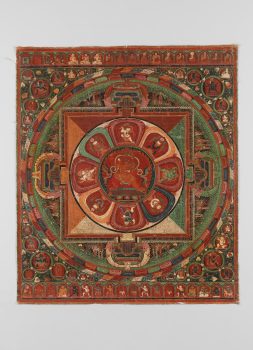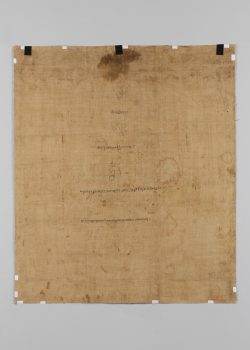Tibet
ca. 1415-1435


Tibet
ca. 1415-1435


The central deity of this five-deity mandala is Red Yamari, the enemy of death, embracing his consort Vajravetali. The wrathful male deity brandishes a skull club and holds a skull cup. The couple is surrounded by four pairs of deities. The male deity in each group is in the color of his respective quarter of the mandala. The intermediate directions are occupied by vases topped by skull cups.The transmission lineage in the top row is inscribed and terminates with the teacher Kunga Lekpa in the top-right corner. Kunga Lekpa, active around 1415 to 1435 in the Kyirong area of Tibet, is also represented as the patron-practitioner (yon bdag) of this painting in the bottom-left corner. The back of the painting contains a dedicatory inscription stating, “This was commissioned as an object for his personal practice by Changphukpa Lama Kunga Lekpa,” provides the context for the creation of this painting.This mandala is largely inspired by Nepalese art, but features the color scheme, bold outlining, and three-lobed arches characteristic of fifteenth-century Tibetan art. Green rivals red as the dominant color, and it is used for many elements of the mandala, including the scrolling lotus stems and the background of the top and bottom rows. The bold black outlines used on each side of the mandala doors and around the tops of the arches in the top and bottom rows help create a sense of depth. Those arches were popular in the art of Gyantse in Tsang Province, southern-central Tibet, to which this painting relates.
A religious movement that originated in India around the fifth to seventh century with sacred writings and esoteric teachings and practices transmitted from teacher to student through initiation. These remain an important part of Hinduism and Buddhism today.
The end of this life marked by the cessation of bodily functions followed by decay. According to Buddhism, after death consciousness transitions to an intermediate state known as the bardo before embarking on another life.
A meditation technique primarily used in tantric practice that involves imagining a deity in one’s mind or imagining oneself becoming a deity and carrying out various activities. Such techniques are intended to help a practitioner transform ordinary perception and achieve enlightened qualities.
A geometrically shaped tool used for meditation and visualization in Buddhist practice. It is a representation of the palace of a deity and the Buddhist conception of the cosmos.
Today, Tibetans primarily inhabit the Tibetan Plateau, situated between the Himalayan mountain range and the Indian subcontinent to the west, Chinese cultural regions to the east, and Mongolian cultural regions to the northeast. During the 7th to 9th century, Tibetan rulers expanded their empire across Central Asia, and established Buddhism as the state religion.
Get the latest news and stories from the Rubin, plus occasional information on how to support our work.